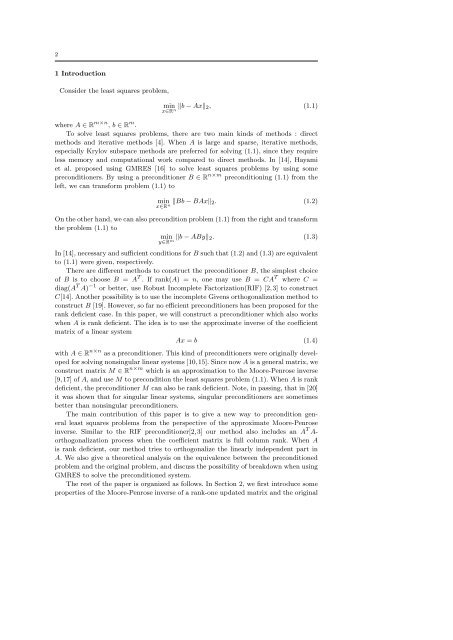Greville's Method for Preconditioning Least Squares ... - Projects
Greville's Method for Preconditioning Least Squares ... - Projects
Greville's Method for Preconditioning Least Squares ... - Projects
You also want an ePaper? Increase the reach of your titles
YUMPU automatically turns print PDFs into web optimized ePapers that Google loves.
2<br />
1 Introduction<br />
Consider the least squares problem,<br />
min ‖b − Ax‖ 2, (1.1)<br />
x∈R n<br />
where A ∈ R m×n , b ∈ R m .<br />
To solve least squares problems, there are two main kinds of methods : direct<br />
methods and iterative methods [4]. When A is large and sparse, iterative methods,<br />
especially Krylov subspace methods are preferred <strong>for</strong> solving (1.1), since they require<br />
less memory and computational work compared to direct methods. In [14], Hayami<br />
et al. proposed using GMRES [16] to solve least squares problems by using some<br />
preconditioners. By using a preconditioner B ∈ R n×m preconditioning (1.1) from the<br />
left, we can trans<strong>for</strong>m problem (1.1) to<br />
min ‖Bb − BAx‖ 2. (1.2)<br />
x∈R n<br />
On the other hand, we can also precondition problem (1.1) from the right and trans<strong>for</strong>m<br />
the problem (1.1) to<br />
min ‖b − ABy‖ 2. (1.3)<br />
y∈R m<br />
In [14], necessary and sufficient conditions <strong>for</strong> B such that (1.2) and (1.3) are equivalent<br />
to (1.1) were given, respectively.<br />
There are different methods to construct the preconditioner B, the simplest choice<br />
of B is to choose B = A T . If rank(A) = n, one may use B = CA T where C =<br />
diag(A T A) −1 or better, use Robust Incomplete Factorization(RIF) [2,3] to construct<br />
C[14]. Another possibility is to use the incomplete Givens orthogonalization method to<br />
construct B [19]. However, so far no efficient preconditioners has been proposed <strong>for</strong> the<br />
rank deficient case. In this paper, we will construct a preconditioner which also works<br />
when A is rank deficient. The idea is to use the approximate inverse of the coefficient<br />
matrix of a linear system<br />
Ax = b (1.4)<br />
with A ∈ R n×n as a preconditioner. This kind of preconditioners were originally developed<br />
<strong>for</strong> solving nonsingular linear systems [10,15]. Since now A is a general matrix, we<br />
construct matrix M ∈ R n×m which is an approximation to the Moore-Penrose inverse<br />
[9,17] of A, and use M to precondition the least squares problem (1.1). When A is rank<br />
deficient, the preconditioner M can also be rank deficient. Note, in passing, that in [20]<br />
it was shown that <strong>for</strong> singular linear systems, singular preconditioners are sometimes<br />
better than nonsingular preconditioners.<br />
The main contribution of this paper is to give a new way to precondition general<br />
least squares problems from the perspective of the approximate Moore-Penrose<br />
inverse. Similar to the RIF preconditioner[2,3] our method also includes an A T A-<br />
orthogonalization process when the coefficient matrix is full column rank. When A<br />
is rank deficient, our method tries to orthogonalize the linearly independent part in<br />
A. We also give a theoretical analysis on the equivalence between the preconditioned<br />
problem and the original problem, and discuss the possibility of breakdown when using<br />
GMRES to solve the preconditioned system.<br />
The rest of the paper is organized as follows. In Section 2, we first introduce some<br />
properties of the Moore-Penrose inverse of a rank-one updated matrix and the original

















